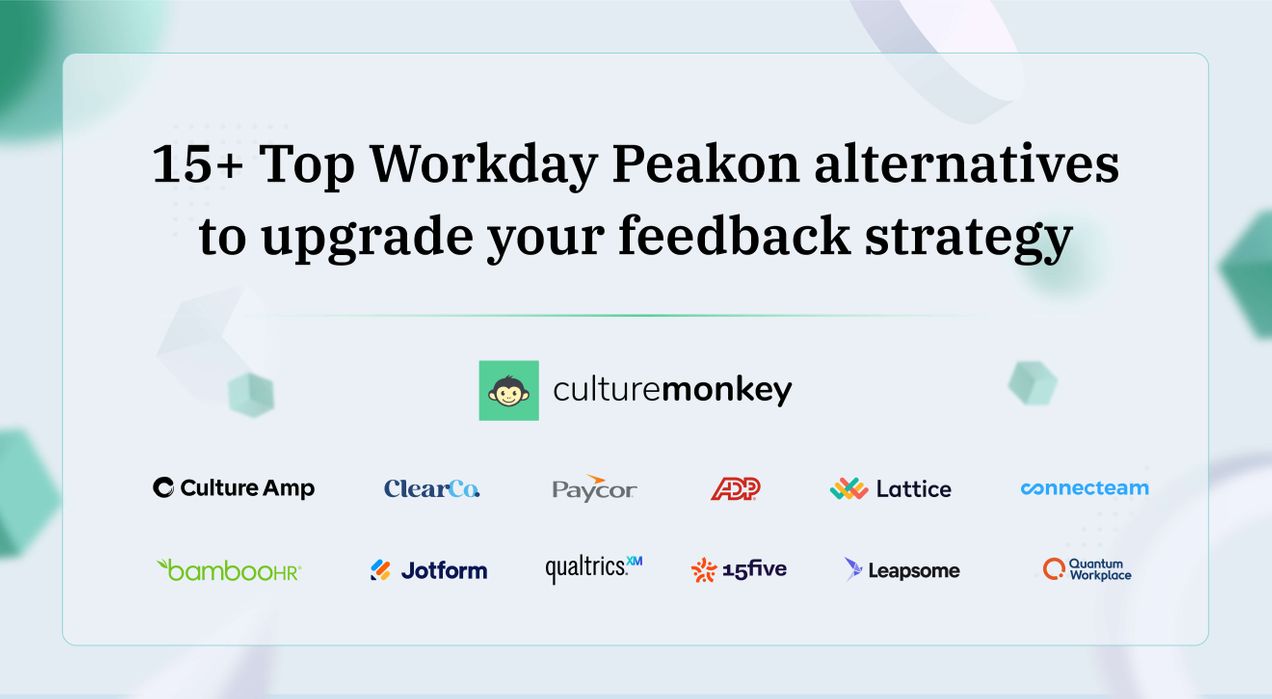Employee engagement survey invitation email sample: Boosting participation with a perfect message

Remember those school days when your friend passed you a folded note that said, “Meet at the canteen after class”? It wasn’t the note itself that made you smile—it was the feeling of being included, of knowing your presence mattered.
That’s exactly what an employee engagement survey invitation should do. It’s not just an email, but it’s an invitation to be heard. The tone, the words, even the subject line can make the difference between silence and sincere participation.
In this blog, we’ll break down how to write an engagement survey invite that feels personal, warm, and impossible to ignore with email samples that help your message land the right way.
- Crafting engaging survey invitation emails boosts participation, and a thoughtful message encourages them to respond honestly.
- Conversational emails beat corporate jargon, as employees feel respected when communication is human, approachable, and direct.
- Strong subject lines capture attention and increase open rates, making employees more likely to engage with the survey invitation.
- Clear, concise invitations reduce hesitation, ensuring employees feel valued, supported, and motivated to share meaningful feedback.
What is an employee engagement survey invitation email?

Think of it this way: you’ve got Netflix asking, “Still watching?” and employees silently screaming, “Still caring?”. An employee engagement survey invitation email is your chance to prove you do. It’s not just another boring corporate note—it’s an open door for employees to share what’s working, what’s not, and what makes them tick at work.
An employee engagement survey invitation email is a message sent to employees encouraging them to participate in a survey about their workplace experience.
Its goal is to boost response rates by being clear, inviting, and making employees feel their voices matter.
The first impression of the survey
Like a movie trailer sets the tone for the film, your invitation email sets the tone for the survey. If it’s dull, no one hits play. If it’s engaging, employees are more likely to click through and respond honestly.
Encouraging participation through a human approach
Forget jargon-heavy lines like “Your valuable input is requested.”. A great survey invitation feels like a friendly nudge from someone who genuinely wants to hear you out. The warmer the tone, the better the participation.
Demonstrating the importance of employee feedback
The email isn’t just a survey link but it’s reassurance that leadership is listening. By telling employees their insights drive change, you’re showing that their voice has weight. And let’s face it, when people feel heard, they’re way more likely to speak up.
You might think it’s just another email link but there’s way more power in that “Send” button than most realize.
Why does your survey invitation email matter more than you think?

Here’s the thing: you can design the best employee surveys in the world, but if the invite lands like a soggy sandwich, no one’s biting. The employee survey email is the unsung hero. It decides whether you get crickets or a flood of survey responses. And honestly, the way you frame that invitation can make or break the entire leadership feedback survey.
- First impressions set the tone: Your invitation is basically the trailer to your leadership feedback survey. If it feels stiff and robotic, employees tune out. But if it’s warm, engaging, and a little fun, they’re far more likely to open, click, and respond.
- It encourages honest feedback: Employees are busy, and they won’t waste time on a survey that feels pointless. A friendly, approachable email signals that their voices matter, encouraging them to provide honest feedback instead of ticking boxes just to get it over with.
- It drives valuable insights: At the end of the day, survey responses are your gold mine. When employees believe the survey is worth their time, they’ll give thoughtful input. That’s how leadership transforms employee surveys into valuable insights that actually spark change.
- It shows respect for employees’ time: No one likes emails that feel like chores. A well-written employee survey email keeps things short, simple, and respectful of time. By showing you value efficiency, you’re more likely to earn participation and gather quality data without annoying employees.
That’s why your invitation email matters more than you think—it’s not just an invite, it’s your survey’s game-changer.
Let’s break down the anatomy of a high-performing engagement survey email and the simple ingredients that get people to actually respond.
What should go into a high-performing engagement survey email?
So, we’ve agreed your survey invitation isn’t just an email—it’s the secret sauce for getting real employee participation. But now the big question is: what exactly should you sprinkle inside that email to make it irresistible? Think of it like hosting a party: the right invite determines whether people show up or ghost you.
Start strong with a friendly greeting like “employee engagement survey dear team.” It feels personal and sets the right tone, unlike robotic intros that make employees feel like they’re trapped in another exit interview survey.
Next, be clear about the purpose. Show how valuable feedback improves employee engagement or builds a positive workplace culture. When employees see the bigger picture, they’re more motivated to respond thoughtfully.
Keep instructions simple. Provide a short survey invite with a visible link and deadline to make participation effortless. Finally, reassure employees their input will shape future events—nothing builds trust faster.
Now that we know what goes inside the email, let’s tackle the first thing employees actually see—the subject line.
How to write a subject line that makes employees want to open it

Alright, so we’ve nailed what goes into a high-performing email—but here’s the truth: none of that matters if no one opens it. Your subject line is the bouncer at the club door; if it’s dull, employees walk right past. To avoid survey fatigue and actually encourage employees to click, you need subject lines that spark curiosity.
1. Keep it short and inviting
Think “A brief survey to help shape our future” instead of “Employee Feedback Form.” Short, punchy subject lines respect time and instantly tell employees this won’t eat into their day.
2. Show leadership team involvement
Add a personal touch from the leadership team. For example: “Your voice matters to [Company Name] leadership” makes employees feel like their input is valued at the very top.
3. Create urgency without pressure
Deadlines can be motivating if done right. A subject line like “Survey invite: share your thoughts before Friday’s survey deadline” is clear, sets expectations, and encourages quick action.
4. Tie it to company culture
Remind employees they’re contributing to something bigger. A line like “Help us build a stronger company culture—your input counts” connects the survey to collective growth, not just data collection.
5. Promise action from feedback
Employees want to know their time won’t be wasted. Subject lines like “Help us collect feedback to improve how we work” assure them their voice will actually influence change.
In short—your subject line should feel like an open door, not a closed meeting invite.
Once your subject line earns the click, the next step is crafting an email length that respects time and keeps attention.
How long should a survey invitation email be?

Picture this: you open your inbox on a busy Monday morning, juggling tasks, deadlines, and maybe even a recent training session. The last thing you want is a wall of text demanding attention. That’s why the length of your employee survey invitation matters more than you think.
A survey invitation email should be short, clear, and respectful of time—ideally under 150 words.
Keep it direct with purpose, timeline, and link so employees feel motivated to respond without feeling burdened.
Keep it short and simple
Think elevator pitch, not novel. A good employee survey invite shouldn’t exceed 150 words. Employees already manage workloads, meetings, and their work life balance. Adding a lengthy email only drains interest. Shorter emails show respect for time and grab attention instantly.
Focus on clarity over fluff
Every line should earn its place. Instead of long intros, explain why the survey matters, how long it’ll take, and what’s in it for employees. Whether it’s pulse surveys or broader initiatives, being clear makes employees feel their participation will deliver actionable feedback.
Connect to culture and growth
Emails should highlight how survey responses impact job satisfaction, work environment, or future employees. When you tie the survey to creating a more inclusive culture or improving daily experiences, employees are more likely to engage meaningfully.
Respect their time, boost participation
An overstuffed email screams “ignore me.” But a concise one reassures employees you value their time. And when time is respected, participation rises—because who doesn’t want to contribute when it feels easy?
In short, keep it clear, light, and purposeful—and employees will click.
After nailing the length, it’s time to fine-tune the emotional side—tone, timing, and trust—to get authentic responses.
Tone, timing, and trust: Key ingredients for better survey responses
- The way you invite employees to take a survey can directly influence employee sentiment and the quality of honest responses.
- A thoughtful survey email template can turn employee surveys into powerful tools that guide ongoing efforts and improve future events.
Here’s the truth: you could design the most brilliant employee engagement employee survey invitation email sample, but if your tone is off, the timing is awkward, or trust is missing, your survey link will sit there collecting dust. Employees are busy humans, not robots waiting for another email.
Let’s dive into the three big ingredients.
The importance of tone
If your email sounds like a stiff corporate memo, expect eye-rolls and low clicks. A survey email template should feel like a friendly nudge, not a command. When you invite employees with warmth and clarity, they’re far more likely to share open, honest responses that actually help.
Why timing is everything
Send your email at the wrong moment—say, during month-end chaos—and it’s game over. Timing signals respect for employees’ workload and attention span. Well-timed invites increase participation, giving you meaningful survey link clicks instead of rushed, half-hearted answers.
Trust builds the bridge
Without trust, employee surveys fall flat. Employees need to know how their feedback will be used. By explaining how responses will guide ongoing efforts and improve future events, you reassure them their voice matters. This builds credibility and stronger employee sentiment.
In the end, tone makes the invite approachable, timing makes it realistic, and trust makes it meaningful. Get these three right, and your employee surveys transform from dreaded inbox clutter into genuine conversations that fuel positive change.
Now that we’ve covered tone and trust, let’s get practical about when to hit send for the best engagement.
What’s the best day and time to send survey invites?

Okay, let’s be honest—sending survey invites at the wrong time is like trying to start a deep conversation while someone’s halfway out the door. Timing matters, and it can completely change whether your employee surveys get thoughtful, honest responses or just a rushed click-click to “get it over with.”
Mondays are chaos with overflowing inboxes and endless meetings, while Fridays are reserved for mentally checking out and planning the weekend. The real sweet spot? Midweek—Tuesday, Wednesday, or Thursday—when employees are more settled, calmer, and have the headspace to give meaningful feedback.
But don’t forget the clock! Send your invite too early in the morning, and it’s buried before lunch. Too late in the day, and everyone’s already eyeing the exit. Late morning, around 10–11 AM, or early afternoon around 2–3 PM, is prime time.
Once you’ve got the timing right, the next question is about format: when should you keep it short and when to go detailed?
Short version vs. detailed version: When to use each format

Remember when we talked about timing being everything? Well, format is its partner in crime. Sometimes your employee survey invitation email needs to be quick and snappy, and other times it needs to spell things out. The trick is knowing which situation calls for which version—because sending the wrong one is like showing up to a wedding in gym shorts.
Short version
Think of the short version as the espresso shot of survey emails. It’s perfect for pulse surveys or when you’re asking employees for quick, specific feedback. A simple subject line, a friendly opener, the survey link, and a deadline—that’s all you need. Use it when you want maximum participation with minimal effort.
Detailed version
The detailed version is more like a full latte with foam art—still digestible, but richer. Use this when you’re running a big employee engagement survey or a leadership feedback survey that demands thoughtful responses. Here, you’ve got room to explain why the survey matters, how the feedback will shape future events, and what employees can expect next. It reassures them that their time leads to real change.
In short, match the format to the purpose. If you just need quick data, go short. If you’re aiming for deep, honest responses, go detailed. Knowing when to use each is how you keep survey emails from being ignored—and turn them into conversations employees actually want to join.
Now that we’ve cracked tone and format, it’s time to address the elephant in the inbox—how to introduce anonymity without sounding robotic.
How to introduce anonymous surveys in the email without sounding robotic

So, you’re ready to roll out employee surveys but here’s the catch—if employees think their names are attached, they might clam up faster than someone at an awkward family dinner. The key? Introduce anonymity in your employee survey email without sounding like a robot spitting policy jargon. Let’s see how.
1. Use friendly reassurance
Instead of stuffing the email with legal-sounding disclaimers, try something simple like, “Your answers are completely anonymous—so be as honest as you like!” A survey email template that reassures without overexplaining helps employees relax and share valuable feedback.
2. Keep the tone human
Ditch the corporate tone and make your message sound like it’s from a real person, not a contract lawyer. Employee survey email templates should feel conversational, almost like a chat over coffee. That warmth encourages higher employee satisfaction and more open responses.
(Source: Official Vermont Government Website)
3. Tie it back to purpose
Don’t just say it’s anonymous—explain why. For instance, highlight how anonymous employee surveys or even an exit interview survey help leadership spot trends, improve policies, and build a healthier workplace. By framing it this way, employees see the survey link as a tool for change, not just data collection.
4. Make it relatable
A quick line like, “We’re only interested in what you think, not who said it” works wonders. Whether in a detailed survey email template or a quick invite, clarity plus relatability ensures employees feel safe enough to hit that survey link and share honestly.
Once the first invite goes out, reminders become your secret weapon. Let’s see how to write them without sounding pushy.
Do you need a follow-up reminder? Here’s what to say and when to send it

So, you sent out your engagement survey and… crickets. Don’t panic, it happens to the best of us. A polite follow-up reminder can be the difference between mediocre response rates and insights that actually improve job satisfaction and the work environment. The trick? Timing and tone.
What to say in a reminder
Skip the robotic copy-paste of your original email. Instead, acknowledge that you know employees are busy, and reassure them the survey only takes a minute to complete. Highlight how their answers will encourage honest, candid feedback that helps shape future pulse surveys and boost overall job satisfaction.
When to send it
Timing matters. Wait a few days after the first invite—enough time for employees to notice, but not so long that they forget. Sending a reminder midweek works best, as it’s less disruptive to work life balance and more likely to catch employees at the right moment.
Add personalization where possible
Even small touches like including the employee name or emphasizing company name values can make reminders feel less generic. This makes the request to collect feedback feel like a genuine conversation rather than spam.
Even the best reminders can fall flat if they repeat the same mistakes that doomed the first email.
Common mistakes in employee survey invitation emails

So, you’ve mastered reminders—but let’s be real, even the best survey email can flop if it’s built on common mistakes. The truth? Employees won’t magically become survey participants just because you send them a link. If you want them to engage, you’ve got to avoid these pitfalls.
Making it too long and boring
Your employee survey isn’t a bedtime story. Overloading an invitation with jargon or unnecessary detail makes people hit delete. Keep it crisp, whether it’s an annual engagement survey or a quick post event feedback survey.
Forgetting to explain the “why”
Employees want to know why their time matters. Failing to explain how survey results will influence training programs, inclusion survey improvements, or even future endeavors makes the whole exercise feel pointless. Always connect the dots.
Sounding too robotic
Nobody wants to open an email that feels colder than exit surveys. Invitations should feel human and relatable. A warm, approachable tone encourages more survey participants to click through and share honest thoughts.
Not showing impact
If employees never see the outcome, why would they bother again? Share how past surveys improved training programs or helped shape future team members’ experiences. Showing the loop from gathering feedback to change builds credibility.
At the end of the day, mistakes are avoidable. Nail your email tone, explain the purpose, and highlight impact—and you’ll turn skipped invites into survey responses worth celebrating.
Now that you know what not to do, here are five ready-to-use employee engagement survey email samples that actually work.
5 Employee engagement survey email samples

Alright, enough theory—let’s get to the good stuff. You’ve avoided the common mistakes, but now you’re staring at a blank screen wondering what to actually write. Don’t worry, I’ve got you. Below are five copy-paste ready email samples you can use to gather feedback without breaking a sweat.
1. Annual engagement survey
Subject: Help us shape the future of [Company Name]
Body: Dear Team, our annual engagement survey is live! It only takes a few minutes, and your input will guide future endeavors and strengthen our workplace. Click the link and share your thoughts.
2. Post event feedback survey
Subject: We’d love your feedback on yesterday’s event
Body: Hi [Employee Name], thank you for attending! Please complete this quick post event feedback survey. Your thoughts will help us improve training programs and future events.
3. Inclusion survey
Subject: Your voice matters—let’s build an inclusive workplace
Body: Dear Colleague, this inclusion survey is your chance to share ideas that shape our culture. Honest feedback will help create a better experience for you and future team members.
4. Exit surveys
Subject: We’d value your feedback before you go
Body: Hi [Employee Name], we’d appreciate you completing this short exit survey. Your feedback helps us refine processes, improve employee satisfaction, and guide future endeavors.
5. Training program survey
Subject: Help us improve our training programs
Body: Hello Team, your survey results matter! Please take this short survey so we can refine training programs and create a better learning path for all survey participants.
Now, how should you personalise the survey email based on workers?
How to adapt your invitation for deskless, remote, or shift-based workers

Now here’s the fun part: not all employees live in their inbox. Some are on the shop floor, others are balancing time zones in remote work experience surveys, and plenty juggle shifts that don’t sync with standard 9-to-5. So how do you make sure they still feel included?
Tailor employee survey email templates to fit different work styles—deskless, remote, or shift-based—so every employee can easily access the survey link.
Flexible, clear invitations boost employee satisfaction, improve employee experience, and ensure survey data reflects everyone, not just office-based staff.
Make it mobile-friendly
Deskless employees aren’t glued to laptops. Employee surveys should use employee survey email templates optimized for mobile, so clicking the survey link is quick and frustration-free. A smooth experience means better survey data and higher employee satisfaction.
Respect time zones and shifts
For remote or shift-based teams, timing is everything. A survey email that hits during sleep hours will likely get ignored. Align reminders with real schedules to make participation feel respectful, not pushy.
Personalize the invite
Whether it’s a new hire feedback survey, exit interview survey, or pulse surveys, adding the company name and a friendly tone makes the invite more relatable. A personalized employee survey email reassures workers their unique employee experience is valued.
When invitations are designed with flexibility and inclusion in mind, employee surveys stop being “another HR thing” and start being a tool everyone feels part of—no matter where or when they work.
“But does an invitation email really make a difference in employee survey participation?”
It’s easy to assume that engagement survey results depend only on leadership action, not the email that launches the survey. But the data says otherwise. When organizations take a data-driven approach to crafting their employee engagement survey invitation emails by personalizing tone, timing, and relevance, the participation rate can soar.
Take Google, for example: by using people analytics to segment audiences and send customized survey invitations, the company achieved an average 90% participation rate in its internal surveys, as stated by HR Curator.
The takeaway? A thoughtful invitation isn’t just about getting clicks but it’s the first moment of trust that determines whether employees choose to speak up at all.
Now that we’ve seen how impactful a strong invitation can be, let’s explore how CultureMonkey simplifies the entire process by making survey launches effortless.
Why CultureMonkey makes employee survey launches easier and faster
If writing survey emails feels like pulling teeth, CultureMonkey is the magic wand you’ve been wishing for. Instead of wasting hours drafting clunky employee survey email templates, you can launch polished, engaging invites in no time. Let’s see how it makes life simpler for every company name.
- Pre-built, customizable templates: Access a library of expertly designed survey templates covering engagement, DEI, well-being, onboarding, and more—so you can launch in minutes, not days.
- Automated scheduling and reminders: Save time by automating survey rollouts and follow-ups. CultureMonkey ensures every employee receives reminders at the right time, improving participation rates effortlessly.
- Multilingual survey support: Launch surveys in multiple languages to include global teams and blue-collar workforces, ensuring every employee’s voice is heard regardless of their preferred language.
- Seamless HRMS and communication tool integrations: Connect CultureMonkey with tools like Slack, Microsoft Teams, and leading HRMS platforms to make survey participation frictionless for employees.
- Real-time participation tracking: Monitor response rates as surveys go live and get instant visibility into engagement levels across departments, helping HR teams adapt and act faster.
- Smart anonymity and segmentation: Guarantee confidentiality with advanced anonymity settings while allowing leaders to analyze results by team, role, or location for deeper insights.
- AI-powered analytics dashboard: As soon as responses come in, CultureMonkey’s AI-driven dashboard visualizes trends, identifies red flags, and recommends actions—so you can move from data to decisions in record time.
Conclusion
At the end of the day, the success of your surveys doesn’t just depend on the questions you ask—it starts with the invite itself. Whether you’re drafting a polished engagement survey email template or figuring out how to invite employees to survey without sounding stiff, the key is to keep it clear, warm, and approachable.
Sometimes, it’s about adding the right anonymous survey email wording so employees feel safe to share honestly. Other times, it’s about choosing an employee feedback email template that reassures staff their voices will directly shape decisions. That’s where CultureMonkey helps. From pre-built templates to smart reminders, CultureMonkey ensures every survey feels like an open conversation. When the invite feels genuine, employees don’t just respond—they engage.
When you get the balance right, surveys stop being a task and start becoming a conversation. Want to make that happen effortlessly? See how our platform turns every survey into a two-way dialogue that builds trust and action. Book a demo with CultureMonkey.
- Crafting the right employee survey email sets the tone of the mail, invites employees warmly, and ensures survey participants feel respected while sharing honest responses.
- Short and engaging employee survey email templates boost response rates and make gathering feedback effortless across various types of surveys.
- Sending survey emails midweek and keeping them conversational encourages better employee sentiment, valuable insights, and stronger survey results.
- Customizing invites for remote, shift-based, or deskless workers improves inclusion, ensuring survey data reflects every employee experience.
- Tools like CultureMonkey simplify survey launches with ready-to-use templates for new hire feedback survey, inclusion survey, and more—thus improving overall employee satisfaction.
FAQs
1. How do I encourage employees to actually open and respond to the survey email?
The trick is making your survey email feel like an opportunity, not a chore. Use a short survey invite email with a clear purpose, highlight how quick it is to complete, and explain why feedback matters most to employees. Personal touches, thoughtful timing, and showing real impact go a long way in boosting employee participation effectively.
2. What tone should the email have, formal or friendly?
A friendly, approachable tone works best for survey invitations. Employees already receive plenty of formal communication, so this is your chance to sound more human and engaging. A conversational approach makes the invite feel personal, natural, and less robotic, encouraging employees to trust the process and engage openly with your employee survey email wholeheartedly and sincerely.
3. Should I tell employees the survey is anonymous?
Yes—always. Using clear anonymous survey email wording reassures employees their feedback won’t be tied to their names. When people feel safe and supported, they’re far more likely to provide honest, candid responses. Reinforcing anonymity builds trust, strengthens survey participation, and ensures the feedback you receive reflects authentic employee sentiment instead of irrelevant cautious or filtered answers.
4. How do I write a subject line that gets clicks?
The best subject lines are short, engaging, and action-oriented. Avoid jargon and make it clear the survey won’t take long, like:
“Your opinion matters—2 minutes to share today.”
Including a real sense of value, urgency, or cultural impact in your survey email template encourages more employees to click, open, and respond thoughtfully, honestly, and consistently always.
5. Can I send a reminder email? How soon is too soon?
Absolutely! Reminders can dramatically improve survey response rates and effectiveness overall. Wait three to five days after the initial email before sending one, so employees don’t feel pressured or overwhelmed. A polite, concise employee feedback email template framed around respect for their time and work life balance encourages genuine participation, making reminders feel like gentle nudges, not nagging messages.





.webp)


